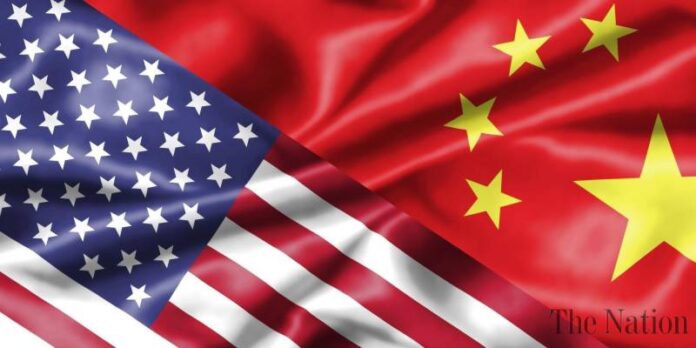The one-time friendly nations are today considered competitors and rivals in the regional and global arenas, despite heavy interdependence and large investments in each other’s country. Almost 50 years ago, in the early 1970s, China and the USA came closer despite sharp differences in economic structure and ideology which also kept in rivalry and enmity, the two superpowers of the time, the USA and the USSR.
The secret visit of Henry Kissinger to Beijing, followed by a long visit Of President Nixon, materialized with the active role of Islamabad, and paved the way for seeking a common ground of friendship. It took another two or three decades to transform their relationship into competition where the superpower USA and qn expansionist and ambitious China began to compare themselves in multiple dimensions, the economy in particular.
From 1980 their economic ties grew rapidly, but did not stop them initiating and maturing a rivalry along with mutual suspicion over each other’s intentions. Gradually, a section of Americans began to view China as a threat to the established order and regional US hegemony States and also feared it would develop into a potential threat to US status as a superpower. In the beginning China rejected the notions but never abandoned its assertive policy and continued seeking new alliances with like-minded countries.
As matters stand today, it is considered a global competition between two superpowers that is multi-layered and multi-dimensional. The competition between the two is not ideological as China did not propagate its ideology like the erstwhile USSR with a plus point that both are more interdependent than America and Russia were.
For the first time President Barack Obama realized the actual strengths of China including its real economic power was approaching to challenge the US economic global status with its potential to surpass the USA in future. He tried to convince China to work with the USA as its junior partner in the region and the world, but Beijing refused to accept the assigned status and asked the USA to view China in its transformed form and with the power it holds. The competition sharpened when Donald Trump became US President and launched a trade war against China.
With his coming the US Administration labelled China a ‘strategic competitor’ in the context of its National Security Strategy and the US Department of Justice’s start of the ‘China Initiative’ which published a detailed report entailing several steps to contain China at regional and global levels, declaring China a currency manipulator. The emerging situation and the overall steps against China made observers feel there was a return of the cold war as bilateral ties of decades were giving way to undue pessimism, hostility, and a zero-sum mindset in almost every area of engagement. By May 2020, the spread of the covid-19 pandemic, the most fatal infectious disease which originated from Wuhan, China, added a new point for Chinese criticism and blame, in addition to the factors which already existed. Trump, keeping in view the strategy in active consideration, also contacted the President of Taiwan and questioned Chinese claims over the Spratly Islands in the South China Sea, extended the relationship with Japan to encircle China and marginalize its influence in the region.
Since Joe Biden’s takeover as US President, though the central theme has not changed, the style of functioning has, as the new leader is more systematic and pragmatic in comparison to his predecessor who always took hectic decisions and always believed in bilateralism rather than multilateralism, which is a necessary technique to encircle China effectively. Although Biden too felt the need to contain China and, recognizing the Beijing’s challenges in view, continues to remain in tt ouch with NATO, G-7 and other multilateral forums to prepare an anti-China environment at regional and global levels and has urged the august bodies to act against the growing Chinese influence as a common challenge for all democratic countries of the world. In response, China said the charges and accusations as baseless and warned the bodies not to be involved in sayings of the USA. In its South Asia policy Trump and Biden concentrated on Pakistan and Afghanistan, currently a complex case for the USA, the region where it engaged in war for the last two decades and is now ready to exit fully. China too is busy there with the active support of Pakistan and the sympathy of the Russian Federation, which is most likely in favour of the Taliban against whom the US launched a war on 7 October 2001, while India, the USA, Japan and other democratic countries want an anti- Taliban elected/democratic regime to assume power in Afghanistan in the larger interest of its people and the political system as well.
The present scenario of South Asia is not very favourable for the USA, as it was earlier when China was like other nations of the region. In the last four decades it has grown rapidly, touching the US capability at least economically and soon likely to match it in every sector. As a result it has totally upset the regional balance of power, especially when it has got the open support of Pakistan and the tacit consent of the Russian Federation.
Unfortunately, the same polarisation is working against the USA in Afghanistan from where the US and NATO forces have exited. Therefore, it has doubled the US responsibility to eye simultaneously the regional peace and stability. as well as facing Chinese rivalry at regional and global levels. The present US dispensation is trying to balance growing Chinese strength and influence with the like-minded democratic countries of the West. It however, is a one-to-one competition which has threatened the position of the USA.
At the regional level, with the US withdrawal from Afghanistan, the terror group of the country is advancing towards achieving its goal, political power, while Chinese scheme of Belt and Road Initiative (BRI), is spreading swiftly, as no such project exists in the USA’s world calculations.























